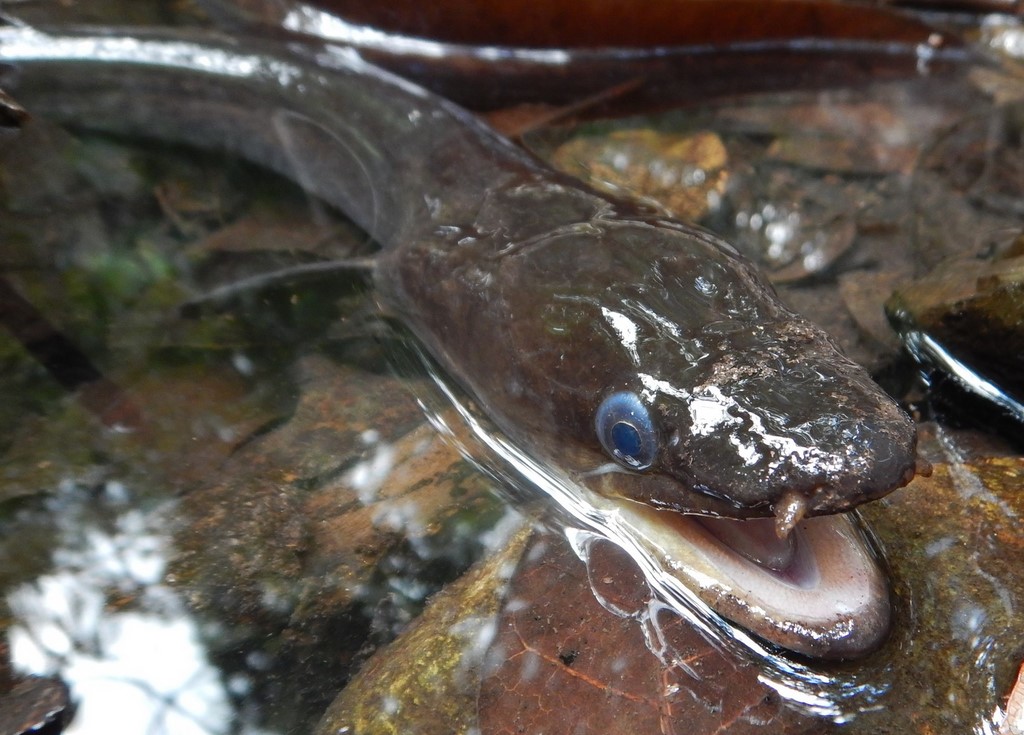ANGUILLA MEGASTOMA - (KAUP, 1856)
Picture courtesy of: Valentin de Mazancourt
Actinopterygii (Gigaclass) > Actinopteri (Superclass) > Teleostei (Class) > Anguilliformes (Order) > Anguilloidei (Suborder) > Anguillidae (Family) > Anguilla (Genus)
Anguille de montagne, Anguille rouge, Pacific longfin eel, Polynesian longfin eel, 大口鰻鱺,
Synonymes
Anguilla aneitensis (Günther, 1870)
Anguilla otaheitensis (Kaup, 1859)
---------------------------
Description
Vertebrae: 108-116. The dorsal and anal fins merge with the caudal fin. Long dorsal fin (origin far in front of the anus). Well-developed pectoral fins. No pelvic fins. Broad, undivided maxillary and mandibular bands of teeth. Max. length: 100.0 cm TL (male), 165.0 cm SL (female). Max. published weight: 9.00 kg. Depth range: 0 - 3000 m.
Color
The skin is grey to yellowish and more or less spotted with brown or black. It can be sometimes uniformly brownish red on the flanks and the back. The belly is white. Young specimens are grey and do not have spots
Etymology
Anguilla: from Latin, anguis = snake. Referring to snake-like body shape (tautonymous with Muraena anguilla Linnaeus, 1758).
megastoma: from Ancient Greek, mégas = great, large, mighty + from Ancient Greek, stóma = mouth. Referring to the dental surfaces of its mouth, described as “very broad”.
Original description: Anguilla megastoma Kaup, 1856 - Type locality: Mangareva, Gambier Islands, French Polynesia.
Distribution
Western Pacific: New Britain (Papua New Guinea) and New Caledonia to Society and Gambier islands.
Biology
Inhabits the upper course of streams within a range of 200-580 m altitude. Feeds at night on crustaceans (especially creekshrimp) and small fish. Catadromous species. The as yet hypothetical spawning area is located to the North-East of Samoa and east of Fiji. Carried by the southeasterly current, leptocephalan larvae appear on the coast after 5-6 months. As they approach the islands, they metamorphose into elvers (47-49mm), which colonize the river mouths (between April and July).
Similar species
Last update: 5, June 2023
Actinopterygii (Gigaclass) > Actinopteri (Superclass) > Teleostei (Class) > Anguilliformes (Order) > Anguilloidei (Suborder) > Anguillidae (Family) > Anguilla (Genus)
Anguille de montagne, Anguille rouge, Pacific longfin eel, Polynesian longfin eel, 大口鰻鱺,
Synonymes
Anguilla aneitensis (Günther, 1870)
Anguilla otaheitensis (Kaup, 1859)
---------------------------
Description
Vertebrae: 108-116. The dorsal and anal fins merge with the caudal fin. Long dorsal fin (origin far in front of the anus). Well-developed pectoral fins. No pelvic fins. Broad, undivided maxillary and mandibular bands of teeth. Max. length: 100.0 cm TL (male), 165.0 cm SL (female). Max. published weight: 9.00 kg. Depth range: 0 - 3000 m.
Color
The skin is grey to yellowish and more or less spotted with brown or black. It can be sometimes uniformly brownish red on the flanks and the back. The belly is white. Young specimens are grey and do not have spots
Etymology
Anguilla: from Latin, anguis = snake. Referring to snake-like body shape (tautonymous with Muraena anguilla Linnaeus, 1758).
megastoma: from Ancient Greek, mégas = great, large, mighty + from Ancient Greek, stóma = mouth. Referring to the dental surfaces of its mouth, described as “very broad”.
Original description: Anguilla megastoma Kaup, 1856 - Type locality: Mangareva, Gambier Islands, French Polynesia.
Distribution
Western Pacific: New Britain (Papua New Guinea) and New Caledonia to Society and Gambier islands.
Biology
Inhabits the upper course of streams within a range of 200-580 m altitude. Feeds at night on crustaceans (especially creekshrimp) and small fish. Catadromous species. The as yet hypothetical spawning area is located to the North-East of Samoa and east of Fiji. Carried by the southeasterly current, leptocephalan larvae appear on the coast after 5-6 months. As they approach the islands, they metamorphose into elvers (47-49mm), which colonize the river mouths (between April and July).
Similar species
- Anguilla australis (Richardson, 1841) - Reported from New Caledonia. Long cylindrical bodies, and continuous dorsal, caudal and anal fins with the dorsal fin originating above or slightly in front of the anal fin.
- Anguilla marmorata (Quoy & Gaimard, 1824) - Reported from New Caledonia - Link to the species (here).
- Anguilla obscura (Günther, 1872) - Reported from New Caledonia. Varying from silver or yellowish to dark brown on the dorsal and lateral surfaces, becoming paler ventrally. The dorsal fin originates before the anus, just in front of, or level with the anal fin origin, and the jaws reach beyond the eye.
- Anguilla reinhardtii (Steindachner, 1867) - Reported from New Caledonia - Link to the species (here). Adults and elvers are distinctly mottled or marbled with olive-green to brown markings, and a paler underside. Mouth large, horizontal, usually reaching just beyond eyes; Gill openings small, just forward of lower half of pectoral fin bases; Dorsal, caudal and anal fins united to form one continuous fin.
Last update: 5, June 2023
